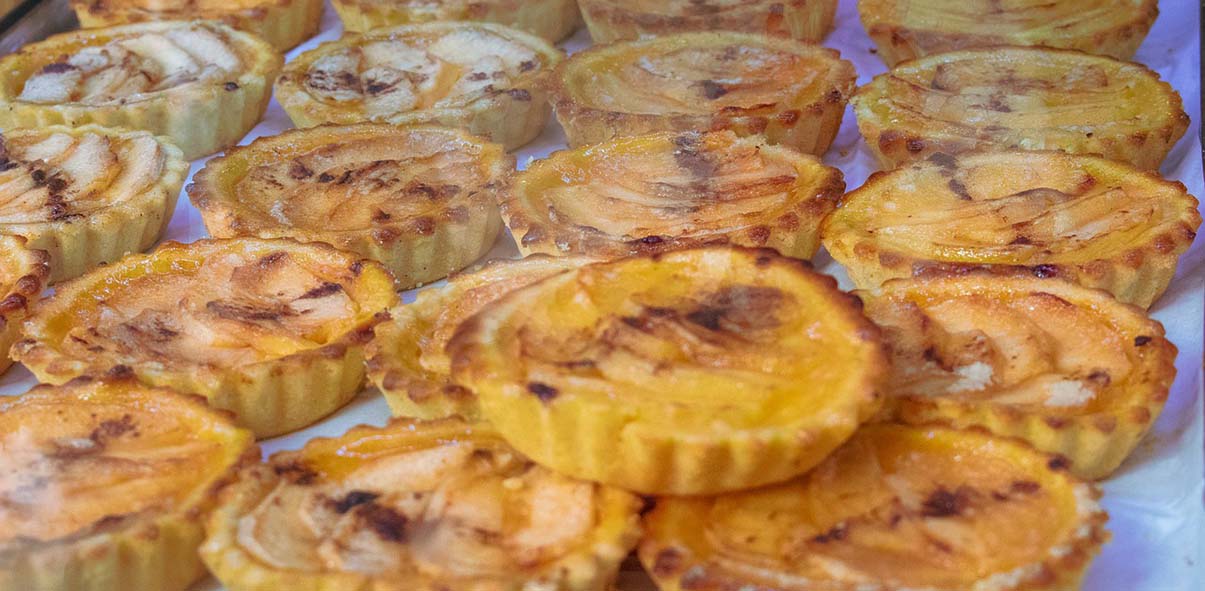
by Jeri Quinzio
Portuguese sweets are divine, which may be because they originated in convents. Back in the 16th century, the country’s Roman Catholic nuns drew on a heritage of Islamic confectionery and an abundance of egg yolks to create unique, delectable pastries. The convents were dissolved early in the 19th century, but fortunately for us the pastries continue to be made, often from the same recipes, and attributed to those long-departed nuns. Today, the pastries are served around the world, from Montreal to Mozambique to Macao, but nowhere are they better than in Portugal.
The pastries are still known as doces conventuais in Portuguese; convent sweets in English. Individual tarts, they consist of a flaky crust and a rich eggy filling, but each convent and, now, each town or even pastry shop has its own special take on the tarts. The filling might be a typical custard or simply ovos moles (translated as soft eggs), which is nothing more than egg yolks and sugar cooked together to create sweet spreadable gold. The nuns had an excess of egg yolks because egg whites were used to clarify wine, to apply gold and silver leaf to church altars, and to starch nun’s wimples, the traditional head covering nuns once wore. They wouldn’t have thought of wasting the leftover egg yolks. They used them to create their sublime pastries.Today, some bakers add, coconut or almonds or even white beans to the filling of their pastéis, or pastries. But I found the basic ovos moles of the famed pastéis de Nata to be the best. The tops of the pastries are baked at such high heat that they’re nearly charred, the pastry is crisp, the eggy filling lusciously creamy and sweet.
In the town of Belém, my friends and I lined up along with dozens of other customers outside a bakery called Antiga Confeitaria de Belém to buy pastéis de Belém, small tarts with a custard filling that’s still warm from the oven. With their lush filling and crackling crisp pastry, they were well worth the wait.
We visited the tiny town of Tentúgal, which is known for its special pastéis du Tentúgal, an oblong pastry filled with ovos moles. At O Afonso, a local pastry shop, we watched as a baker took an eight-pound lump of dough made from nothing but flour and water and stretched and flipped it until it covered an area of probably 12 by 15 feet. By the time she was through, the dough was thin enough to read through.
After it was stretched to her satisfaction, she cut it into small shapes, layered a few, and added some pastry scraps in the center for extra strength. She then dipped a feather into clarified butter and ever so delicately sprinkled a few drops of the melted butter onto the pastry. Next, she spooned a line of the egg yolk and sugar filling onto the pastry. She quickly rolled it into a rectangle, folded the ends up, and placed it on a baking sheet along with dozens of others and put them in an intensely hot oven. When they were baked, the folded ends of the pastries formed little ruffles, the pastry itself was shatteringly crisp, and the filling was heavenly. The pastry is made with just five simple ingredients – flour, water, butter, sugar, and egg yolks – but with consummate skill and many years of practice.
There are other sweets in Portugal, and you’ll find a pastry shop on nearly every street. Home cooks in Portugal also excel at desserts. We visited one home where we were greeted with a creamy rich rice pudding topped with cinnamon spelling out the word “Welcome.” Portuguese bakers and home cooks use cinnamon to decorate as well as flavor their puddings.
While I was in Portugal, I also sampled cookies and cakes and ice cream and even a few desserts using egg whites. I loved the simple crisp meringues called suspiros, or sighs, a perfect name. Another favorite was a dessert called Molotov for reasons no one could explain to me. It’s similar to Floating Island. Made two ways, it may be a poached meringue in a pool of custard, as we would expect. Or it can be a baked meringue served with a caramel sauce. Both are light and delectable, however the name remains a mystery.
All of the Portuguese sweets are good, but the egg yolk pastries originated so long ago by the nuns are special. Visiting Portugal without indulging in at least a few convent sweets would be sinful.
Portugal abounds in pastry shops. There’s one on nearly every corner, and every one is filled with tempting tastes. These are just two of my favorites.
The home of pastéis du Tentúgal is:
O Afonso
N 111 Estradas Nacionas
Tentúgal, Portugal
The home of pastéis de Belém is:
Antiga Confeitaria de Belém
R. de Belém 84 92
1300-085 Lisboa, Portugal
About the author:
Jeri Quinzio is a freelance writer whose latest book is Dessert: A Tale of Happy Endings.
Food historian Ken Albala called it “a perfectly delightful romp through the history of puddings and cakes and custards, everything from syllabubs to strawberry ice cream. Bring a big spoon.”
Any local or expat on a Portugal golden visa will tell you that the convent pastries are not to be missed.


Leave a Reply
You must be logged in to post a comment.